自动化专业英语考试
- 格式:pdf
- 大小:245.05 KB
- 文档页数:7
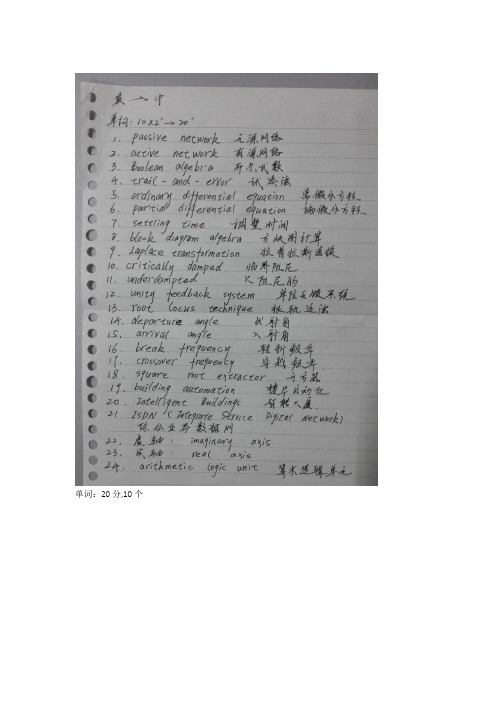
单词:20分,10个
二;句子翻译:40分,8题
1:P2
A common method of analyzing an electrical network is mesh or loop analysis.The fundamental law that is applied in this method is Kirchhoff's first law,which states that the algebraic sun of the
voltages around a closed loop is0,or,in any closed loop,the sum of the voltage rises must equal the sum of the voltage drops.Mesh analysis consists of assuming that currents~termed loop
currents~flow in each loop of a network,algebraically summing the voltage drops around each loop,and setting each sum equal to0.
分析电网络的一般方法是网孔分析法或回路分析法;应用于此方法的基本定律是基尔霍夫第一定律,基尔霍夫第一定律指出:一个闭合回路中的电压代数和为0,换句话说,任一闭合回路中的电压升等于电压降;网孔分析指的是:假设有一个电流——即所谓的回路电流——流过电路中的每一个回路,求每一个回路电压降的代数和,并令其为零;

自动化专业英语
Title: Professional English in Automation
Introduction:
Professional English in the field of automation is essential for effective communication and collaboration in the industry. It is important for professionals in this field to have a strong command of technical vocabulary and terminology to ensure accuracy and clarity in their work. In this article, we will explore the importance of professional English in automation and provide some tips for improving language skills in this specialized area.
1. Importance of Professional English in Automation
1.1. Precision and Accuracy: In the field of automation, precision and accuracy are crucial for successful project implementation. Professional English helps in conveying technical information accurately, reducing the risk of errors and misunderstandings.
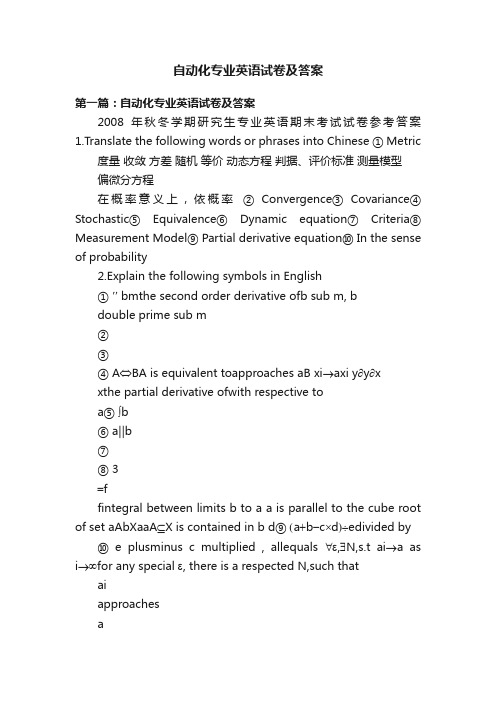
自动化专业英语试卷及答案
第一篇:自动化专业英语试卷及答案
2008年秋冬学期研究生专业英语期末考试试卷参考答案1.Translate the following words or phrases into Chinese ① Metric
度量收敛方差随机等价动态方程判据、评价标准测量模型
偏微分方程
在概率意义上,依概率② Convergence③ Covariance④ Stochastic⑤ Equivalence⑥ Dynamic equation⑦ Criteria⑧ Measurement Model⑨ Partial derivative equation⑩ In the sense of probability
2.Explain the following symbols in English
① '' bmthe second order derivative ofb sub m, b
double prime sub m
②
③
④ A⇔BA is equivalent toapproaches aB xi→axi y∂y∂x
xthe partial derivative ofwith respective to
a⑤ ⎰b
⑥ a‖b
⑦
⑧ 3
=f
fintegral between limits b to a a is parallel to the cube root of set aAbXaaA⊆X is contained in b d⑨ (a+b-c⨯d)÷edivided by ⑩ e plusminus c multiplied , allequals ∀ε,∃N,s.t ai→a as i→∞for any special ε, there is a respected N,such that ai
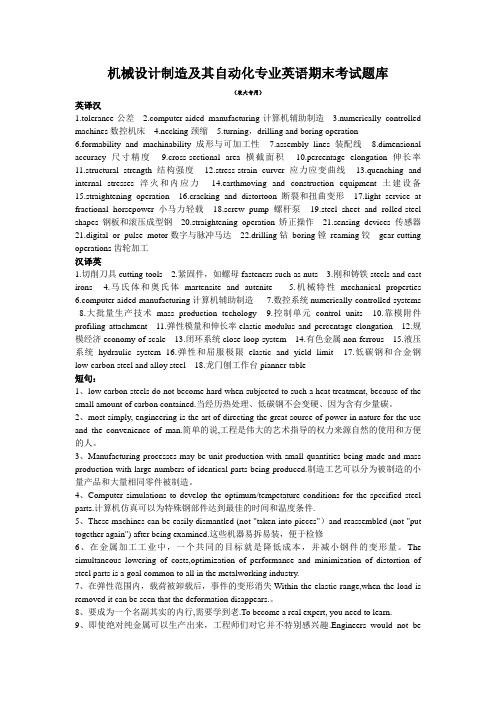
机械设计制造及其自动化专业英语期末考试题库
(农大专用)
英译汉
1.tolerance公差
puter-aided manufacturing计算机辅助制造
3.numerically controlled machines数控机床
4.necking颈缩
5.turning,drilling and boring operation
6.formability and machinability成形与可加工性
7.assembly lines装配线
8.dimensional accuracy尺寸精度
9.cross-sectional area横截面积10.percentage elongation伸长率11.structural strength结构强度12.stress-strain curver应力应变曲线13.quenching and internal stresses淬火和内应力14.earthmoving and construction equipment土建设备15.straightening operation 16.cracking and distortoon断裂和扭曲变形17.light service at fractional horsepower小马力轻载18.screw pump螺杆泵19.steel sheet and rolled-steel shapes钢板和滚压成型钢20.straightening operation矫正操作21.sensing devices 传感器21.digital or pulse motor数字与脉冲马达22.drilling钻boring镗reaming铰gear-cutting operations齿轮加工
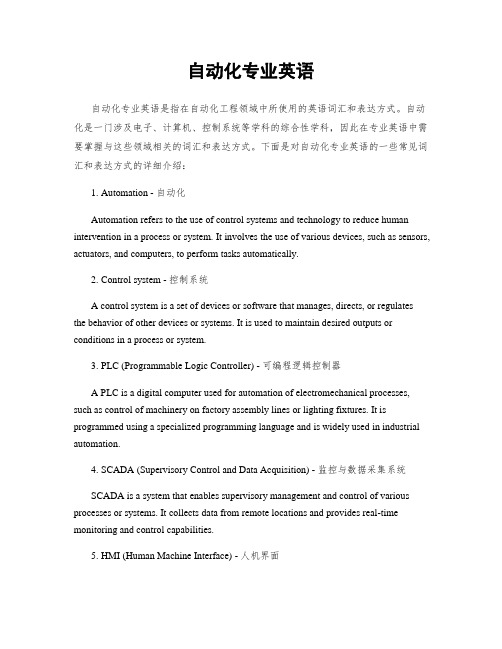
自动化专业英语
自动化专业英语是指在自动化工程领域中所使用的英语词汇和表达方式。自动化是一门涉及电子、计算机、控制系统等学科的综合性学科,因此在专业英语中需要掌握与这些领域相关的词汇和表达方式。下面是对自动化专业英语的一些常见词汇和表达方式的详细介绍:
1. Automation - 自动化
Automation refers to the use of control systems and technology to reduce human intervention in a process or system. It involves the use of various devices, such as sensors, actuators, and computers, to perform tasks automatically.
2. Control system - 控制系统
A control system is a set of devices or software that manages, directs, or regulates the behavior of other devices or systems. It is used to maintain desired outputs or conditions in a process or system.
3. PLC (Programmable Logic Controller) - 可编程逻辑控制器
A PLC is a digital computer used for automation of electromechanical processes, such as control of machinery on factory assembly lines or lighting fixtures. It is programmed using a specialized programming language and is widely used in industrial automation.
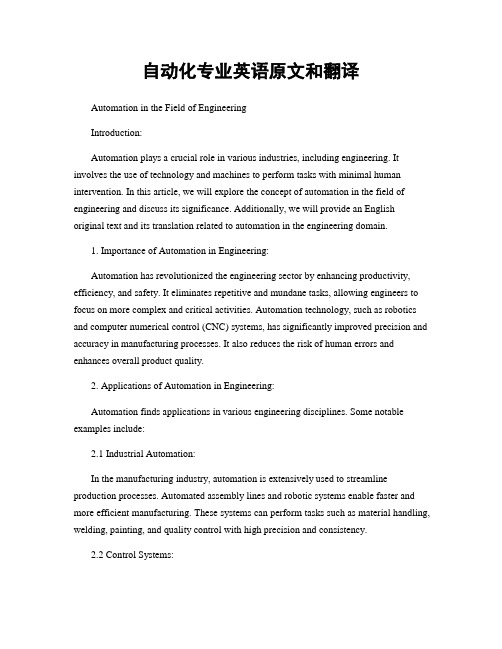
自动化专业英语原文和翻译
Automation in the Field of Engineering
Introduction:
Automation plays a crucial role in various industries, including engineering. It involves the use of technology and machines to perform tasks with minimal human intervention. In this article, we will explore the concept of automation in the field of engineering and discuss its significance. Additionally, we will provide an English original text and its translation related to automation in the engineering domain.
1. Importance of Automation in Engineering:
Automation has revolutionized the engineering sector by enhancing productivity, efficiency, and safety. It eliminates repetitive and mundane tasks, allowing engineers to focus on more complex and critical activities. Automation technology, such as robotics and computer numerical control (CNC) systems, has significantly improved precision and accuracy in manufacturing processes. It also reduces the risk of human errors and enhances overall product quality.

自动化专业英语
自动化专业英语是指在自动化工程领域中使用的英语专业术语和表达方式。自
动化工程是一门综合性学科,涉及到计算机科学、电子工程、控制工程等多个领域。在国际交流和合作中,掌握自动化专业英语是非常重要的。
一、自动化基础知识
1. 自动化(Automation)是指利用计算机、电子技术和控制理论等手段,使各
种生产过程、生活服务和管理活动实现自动化的技术和方法。
2. 控制系统(Control System)是指通过传感器检测被控对象的状态,并通过
执行器对其进行控制的系统。
3. 传感器(Sensor)是指能够将被测量的物理量转换为可读取的电信号的装置。
4. 执行器(Actuator)是指能够根据控制信号进行动作的装置,如电机、气缸等。
5. 反馈(Feedback)是指将控制系统输出的结果与期望值进行比较,并根据比
较结果对系统进行修正的过程。
二、自动化设备与系统
1. PLC(Programmable Logic Controller)是一种用于工业自动化控制的可编程
逻辑控制器,广泛应用于工厂生产线、机械设备等。
2. SCADA(Supervisory Control and Data Acquisition)是一种用于监控和控制
大型工业系统的软件系统,通常与PLC配合使用。
3. DCS(Distributed Control System)是一种分布式控制系统,用于对工厂生产
过程进行实时监控和控制。
4. HMI(Human Machine Interface)是一种人机界面设备,用于与自动化系统
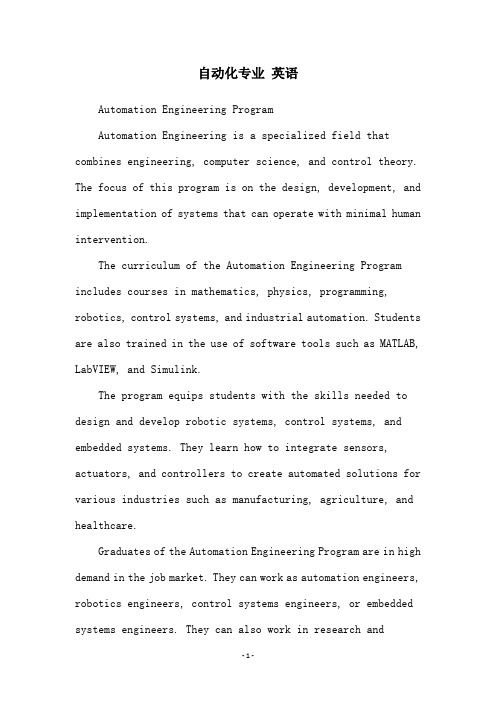
自动化专业英语
Automation Engineering Program
Automation Engineering is a specialized field that combines engineering, computer science, and control theory. The focus of this program is on the design, development, and implementation of systems that can operate with minimal human intervention.
The curriculum of the Automation Engineering Program includes courses in mathematics, physics, programming, robotics, control systems, and industrial automation. Students are also trained in the use of software tools such as MATLAB, LabVIEW, and Simulink.
The program equips students with the skills needed to design and develop robotic systems, control systems, and embedded systems. They learn how to integrate sensors, actuators, and controllers to create automated solutions for various industries such as manufacturing, agriculture, and healthcare.
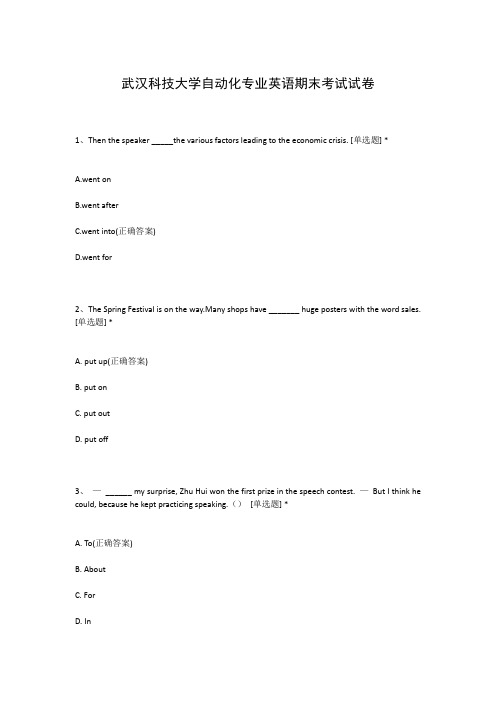
武汉科技大学自动化专业英语期末考试试卷
1、Then the speaker _____the various factors leading to the economic crisis. [单选题] *
A.went on
B.went after
C.went into(正确答案)
D.went for
2、The Spring Festival is on the way.Many shops have _______ huge posters with the word sales. [单选题] *
A. put up(正确答案)
B. put on
C. put out
D. put off
3、—______ my surprise, Zhu Hui won the first prize in the speech contest. —But I think he could, because he kept practicing speaking.()[单选题] *
A. To(正确答案)
B. About
C. For
D. In
4、Bob is young, _______ he knows a lot. [单选题] *
A. because
B. so
C. but(正确答案)
D. unless
5、Leave your key with a neighbor ___ you lock yourself out one day [单选题] *
A. ever since
B. even if
C. soon after

自动化专业英语
标题:自动化专业英语
引言概述:自动化专业英语是指在自动化领域中使用的专业术语和表达方式。掌握自动化专业英语对于从事自动化工程、机器人技术、控制系统等相关工作的人员至关重要。本文将从自动化专业英语的基本概念、常用术语、学习方法、应用场景和发展趋势等方面进行详细阐述。
一、基本概念
1.1 自动化:指通过使用各种控制设备和系统,实现对生产过程、机器设备或者其他系统的自动控制和运行。
1.2 专业英语:是指在特定领域或者专业中使用的专门术语、表达方式和语言规范。
1.3 自动化专业英语:是指在自动化领域中使用的专业术语和表达方式,涵盖了自动化工程、控制系统、机器人技术等方面的专业术语和表达。
二、常用术语
2.1 PLC(Programmable Logic Controller):可编程逻辑控制器,是一种用于工业控制系统中的数字计算机。
2.2 SCADA(Supervisory Control and Data Acquisition):监控与数据采集系统,用于监控、控制和数据采集的软件系统。
2.3 HMI(Human Machine Interface):人机界面,是人与机器系统进行交互的界面设备,如触摸屏、显示器等。
三、学习方法
3.1 注重实践:通过实际操作和项目实践来学习自动化专业英语,加深对术语和表达方式的理解。
3.2 多听多说:多听英语专业讲座、视频或者访谈,多与专业人士交流,提高自动化专业英语的听说能力。
3.3 利用工具:使用专业英语词典、在线翻译工具和专业术语数据库,辅助学习和工作中的应用。
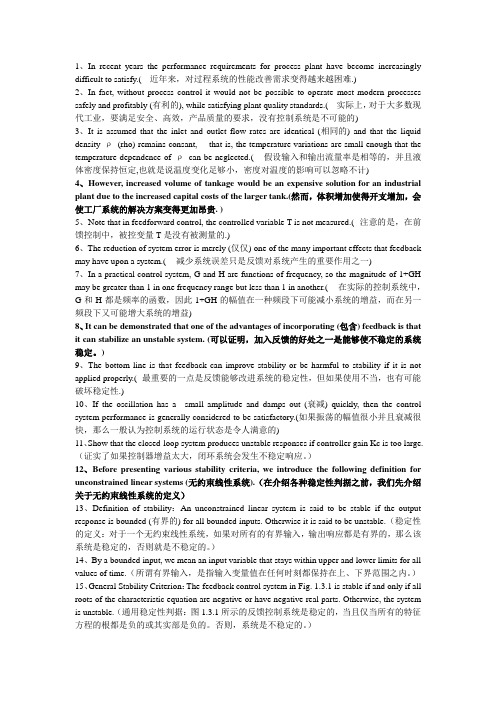
1、In recent years the performance requirements for process plant have become increasingly difficult to satisfy.(近年来,对过程系统的性能改善需求变得越来越困难.)
2、In fact, without process control it would not be possible to operate most modern processes safely and profitably (有利的), while satisfying plant quality standards.(实际上,对于大多数现代工业,要满足安全、高效,产品质量的要求,没有控制系统是不可能的)
3、It is assumed that the inlet and outlet flow rates are identical (相同的) and that the liquid density ρ(rho) remains consant,that is, the temperature variations are small enough that the temperature dependence of ρcan be neglected.(假设输入和输出流量率是相等的,并且液体密度保持恒定,也就是说温度变化足够小,密度对温度的影响可以忽略不计)
4、However, increased volume of tankage would be an expensive solution for an industrial plant due to the increased capital costs of the larger tank.(然而,体积增加使得开支增加,会使工厂系统的解决方案变得更加昂贵. )

自动化专业英语
自动化专业英语是指在自动化工程领域中使用的英语专业术语和表达方式。在
自动化领域中,英语作为国际通用语言,具有重要的交流和合作作用。掌握自动化专业英语对于从事自动化工程的专业人士来说,是非常重要的。
一、自动化概述
自动化是指利用各种设备和技术手段,使某一系统或过程在无人操作或少人操
作的情况下,能够自动地完成工作任务。自动化技术广泛应用于工业、农业、交通、航空航天等领域,以提高生产效率、降低成本和提高产品质量。
二、自动化专业英语词汇
1. Automation - 自动化
2. Control system - 控制系统
3. Sensor - 传感器
4. Actuator - 执行器
5. Programmable logic controller (PLC) - 可编程逻辑控制器
6. Human-machine interface (HMI) - 人机界面
7. Supervisory control and data acquisition (SCADA) - 监控与数据采集系统
8. Industrial Internet of Things (IIoT) - 工业物联网
9. Robotics - 机器人技术
10. Artificial intelligence (AI) - 人工智能
三、自动化专业英语常用表达
1. The automation industry is rapidly growing. - 自动化行业发展迅速。
2. The control system regulates the operation of the machinery. - 控制系统调节机械的运行。
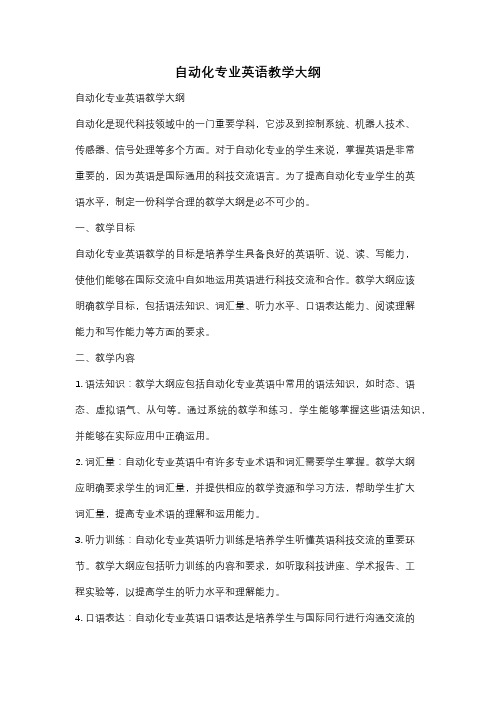
自动化专业英语教学大纲
自动化专业英语教学大纲
自动化是现代科技领域中的一门重要学科,它涉及到控制系统、机器人技术、
传感器、信号处理等多个方面。对于自动化专业的学生来说,掌握英语是非常
重要的,因为英语是国际通用的科技交流语言。为了提高自动化专业学生的英
语水平,制定一份科学合理的教学大纲是必不可少的。
一、教学目标
自动化专业英语教学的目标是培养学生具备良好的英语听、说、读、写能力,
使他们能够在国际交流中自如地运用英语进行科技交流和合作。教学大纲应该
明确教学目标,包括语法知识、词汇量、听力水平、口语表达能力、阅读理解
能力和写作能力等方面的要求。
二、教学内容
1. 语法知识:教学大纲应包括自动化专业英语中常用的语法知识,如时态、语态、虚拟语气、从句等。通过系统的教学和练习,学生能够掌握这些语法知识,并能够在实际应用中正确运用。
2. 词汇量:自动化专业英语中有许多专业术语和词汇需要学生掌握。教学大纲
应明确要求学生的词汇量,并提供相应的教学资源和学习方法,帮助学生扩大
词汇量,提高专业术语的理解和运用能力。
3. 听力训练:自动化专业英语听力训练是培养学生听懂英语科技交流的重要环节。教学大纲应包括听力训练的内容和要求,如听取科技讲座、学术报告、工
程实验等,以提高学生的听力水平和理解能力。
4. 口语表达:自动化专业英语口语表达是培养学生与国际同行进行沟通交流的
关键。教学大纲应包括口语表达的训练内容和要求,如进行小组讨论、演讲、
模拟面试等,以提高学生的口语表达能力和自信心。
5. 阅读理解:自动化专业英语阅读理解是培养学生理解和运用英语科技文献的

翻译
P。1
The voltage across a pure inductor is defined by Faraday’law,which states that the voltage across the inductor is proportional to the rate of change with time of the current through the inductor。thus we have U=Ldi/dt.
纯电感电压由法拉第定律定义,法拉第定律指出:电感两端的电压正比于流过电感的电流随时间的变化率.因此可得到:U=Ldi/dt 式中di/dt = 电流变化率,安培/秒;L = 感应系数, 享利。
P.3
A three—phase electric circuit is energized by three alternating emfs of the same frequency and differing in time phase by 120 electrical degrees . 三相电压的产生三相电路可由三个频率相同在时间相位上相差120°电角度的电动势供电。
P.9
One problem with electronic devices corresponding to the generalized amplifiers is that the gains,AU or AI ,depend upon internal properties of two-port system( )。This makes design difficult since these parameters usually vary from device to device ,as well as temperature 。运算放大器像广义放大器这样的电子器件存在的一个问题就是它们的增益AU或AI取决于双端口系统(m、b、RI、Ro等)的内部特性。器件之间参数的分散性和温度漂移给设计工作增加了难度。
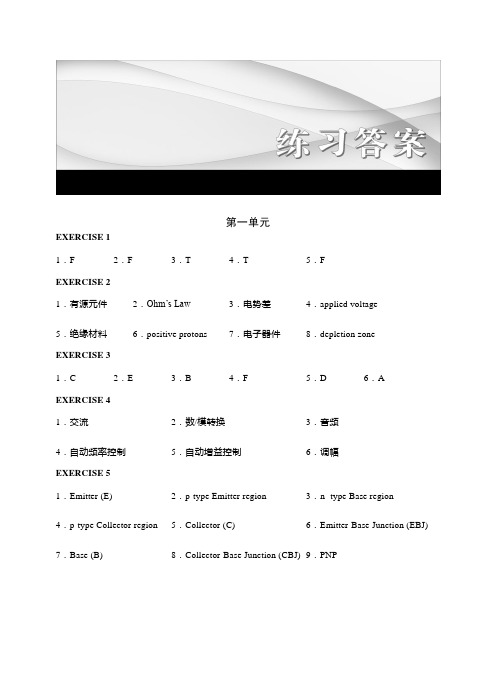
第一单元
EXERCISE 1
1.F 2.F 3.T 4.T 5.F
EXERCISE 2
1.有源元件2.Ohm’s Law3.电势差4.applied voltage
5.绝缘材料6.positive protons 7.电子器件8.depletion zone EXERCISE 3
1.C 2.E 3.B 4.F 5.D 6.A EXERCISE 4
1.交流2.数/模转换3.音频
4.自动频率控制5.自动增益控制6.调幅
EXERCISE 5
1.Emitter (E) 2.p-type Emitter region 3.n- type Base region
4.p-type Collector region 5.Collector (C) 6.Emitter-Base Junction (EBJ)
7.Base (B) 8.Collector-Base Junction (CBJ) 9.PNP
练习答案
242
EXERCISE 7
1.B 2.A 3.D 4.E 5.C
第二单元
EXERCISE 1
1.F 2.T 3.F 4.F 5.T
EXERCISE 2
1.混合电路2.numeric value 3.离散值4.digital circuit 5.调谐电路6.printed circuit board 7.替换模型8.closed path EXERCISE 3
1.C 2.D 3.B 4.A
EXERCISE 4
1.异步传输模式2.计算机辅助教学3.电荷耦合器件
4.码分多址5.压缩只读光盘6.数字信号处理EXERCISE 5
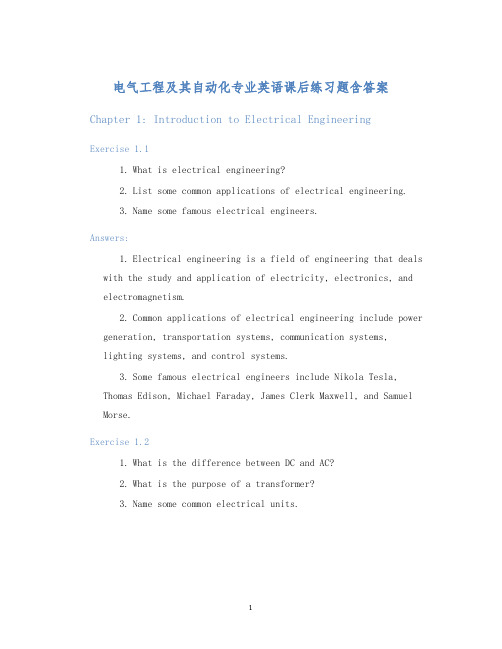
电气工程及其自动化专业英语课后练习题含答案Chapter 1: Introduction to Electrical Engineering
Exercise 1.1
1.What is electrical engineering?
2.List some common applications of electrical engineering.
some famous electrical engineers.
Answers:
1.Electrical engineering is a field of engineering that deals
with the study and application of electricity, electronics, and electromagnetism.
mon applications of electrical engineering include power
generation, transportation systems, communication systems,
lighting systems, and control systems.
3.Some famous electrical engineers include Nikola Tesla,
Thomas Edison, Michael Faraday, James Clerk Maxwell, and Samuel Morse.
Exercise 1.2
1.What is the difference between DC and AC?